
For us, a bucket list of unique things to do in Iceland should include: fun things to do in Iceland, off the path Iceland attractions, the best caving in Iceland, snorkeling between two of the earth’s tectonic plates, things to do in Iceland for foodies and beer lovers, and much more!
Let’s face it: Iceland is getting a lot of buzz these days in travel circles, and with a lot of buzz comes a lot of visitors. Iceland is a hot destination – to coin a paradoxical phrase! But before you dismiss Iceland as too touristy for fear of running into hordes of other visitors, consider our suggestions for unique things to do in Iceland that will have you experiencing this country in different and interesting ways.
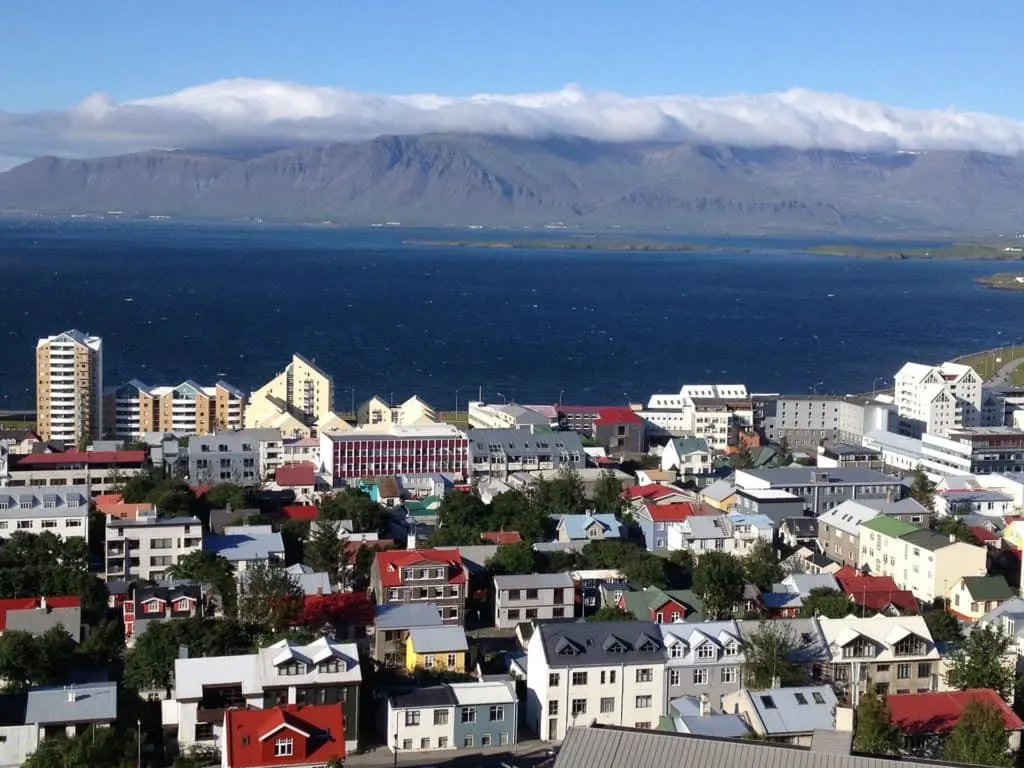
How to Build a Unique Bucket List of Fun Things to Do in Iceland
If it’s your first visit, you’re going to want to see popular attractions as well as make time for off the beaten path things to do in Iceland. Just as we usually advise first time visitors to any new destination, there’s a reason certain fun things to do in Iceland have become so popular: it’s because they’re just so spectacular!
It’s your decision on how many of the big attractions like the Blue Lagoon, the many amazing waterfalls, the Golden Circle road trip, geysers and hot springs, and glaciers you want to put on your list.

To see the spectacular natural attractions safely and independently, get a 4×4 rental car in Iceland to ensure you are ready for all kinds of weather and conditions. Depending upon your plans you will want to consider an SUV, camper van, or a vehicle with rooftop tent.
But other unique things to do in Iceland abound! There are so many off the path Iceland attractions that will pique your particular interests. Historic attractions in Iceland cover centuries of Nordic settlement, folklore and traditions.
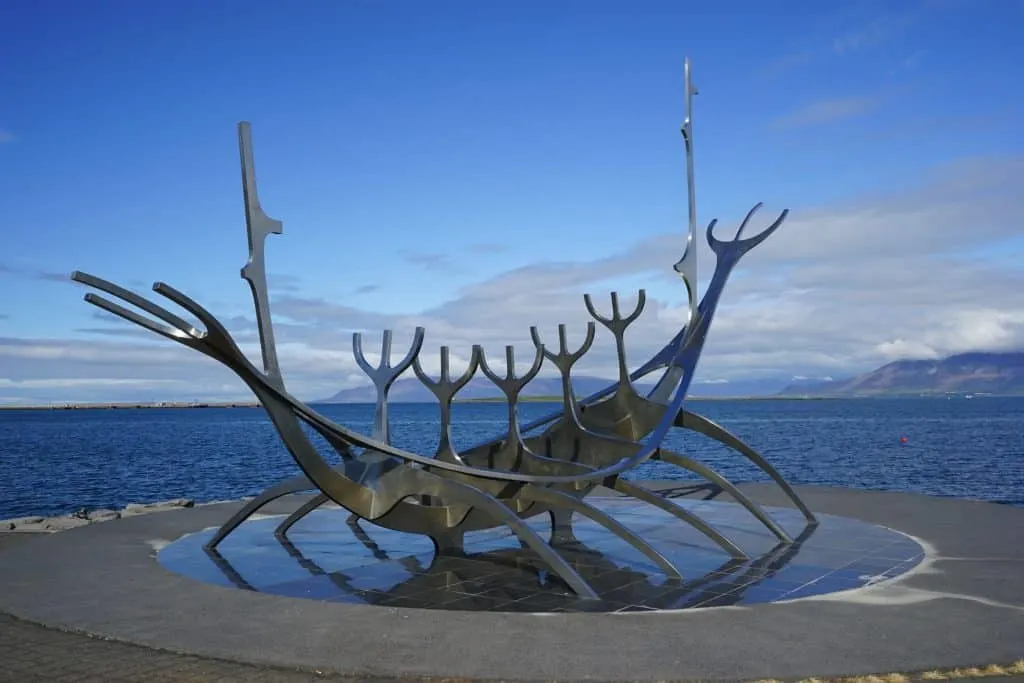 Unusual opportunities in the great outdoors aside from hiking and trekking are available here, too. Consider that some of the best caving in Iceland will take you to magical, underground realms of lakes and waterfalls, straight out of a supernatural saga. If you’ve never thought of diving or snorkeling in Iceland, you’re in for some of the most unusual conditions you might have encountered to date.
Unusual opportunities in the great outdoors aside from hiking and trekking are available here, too. Consider that some of the best caving in Iceland will take you to magical, underground realms of lakes and waterfalls, straight out of a supernatural saga. If you’ve never thought of diving or snorkeling in Iceland, you’re in for some of the most unusual conditions you might have encountered to date.
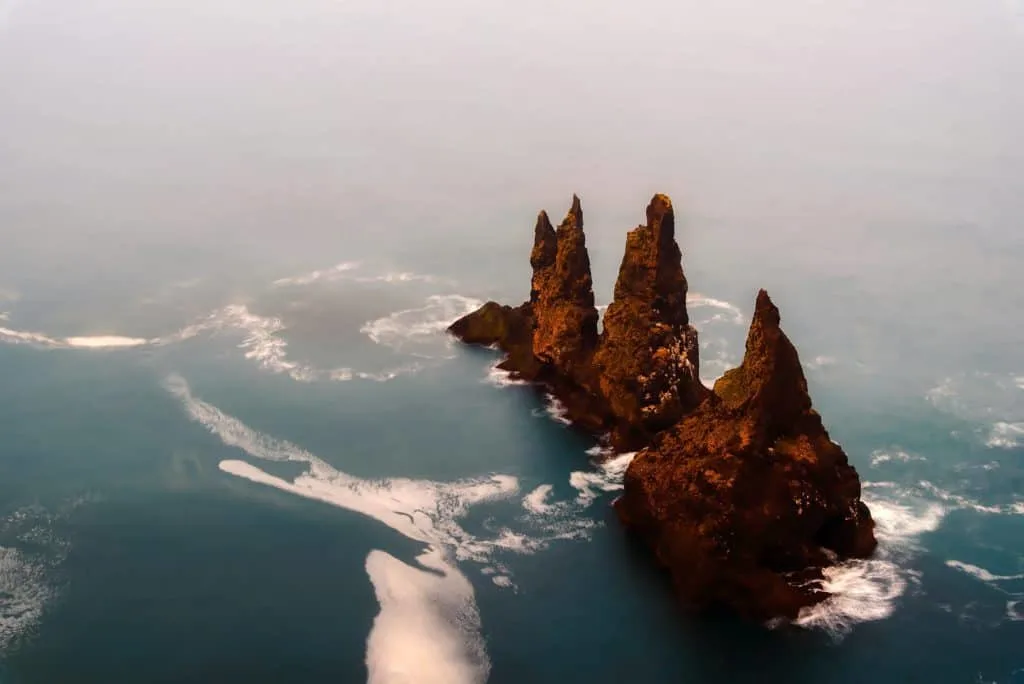
Are you more of an indoor enthusiast? You’ll find plenty of fun things to do in Iceland! From souvenir shopping for toasty warm Icelandic knitwear to handmade jewelry and artisan crafts, retail therapy will yield a bonanza.
Wondering about fine dining in Iceland? The emerging gastronomic scene ensures plenty of things to do in Iceland for foodies and wine enthusiasts. In search of the perfect pour? We’ll share a variety of specific things to do in Iceland for beer lovers, too.
In short, Iceland is a destination you can consider for a variety of bucket list-worthy items to ensure your visit is as unique as you are! Let’s look at some of them:
Off the Beaten Path Things to Do in Iceland’s Great Outdoors
Visitors come to Iceland for the majestic and other-worldly scenery, which is the result of geo-thermal forces and volcanic activity which occurs to this day. Iceland, despite its northern location close to the Arctic Circle, has a relatively temperate climate by comparison with other Arctic locations. This leads to a variety of unique things to do in Iceland that other destinations cannot boast.
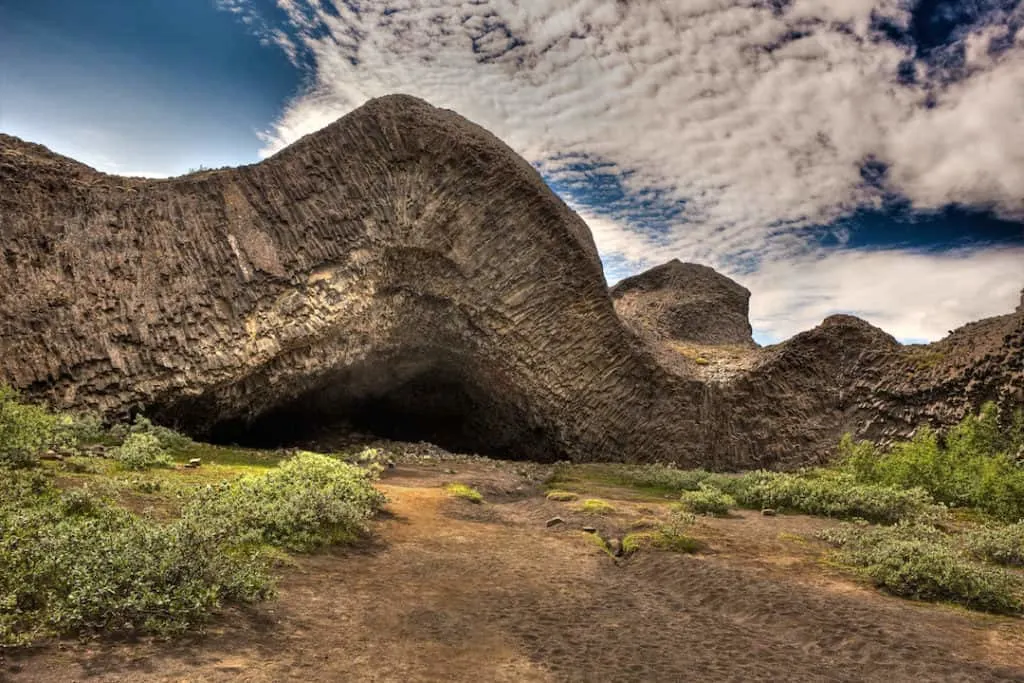
Photo Credit: iceland.is
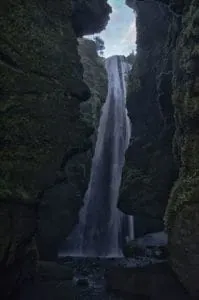 Caving in Iceland
Caving in Iceland
Only about a quarter of the island has vegetation; instead, the landscape is comprised of volcanic rock formations, glaciers, rivers, waterfalls. Some of the best caving in Iceland is done in ice – the mesmerizing Jokulsarlon Ice Cave – and a dormant volcano: Thrihnjukagigur.
These are just two off the path Iceland attractions prized by caving enthusiasts. Others not to miss: Grjotagja, a small volcanic cave – and Game of Thrones location! – with a thermal spring and Gljufrafoss, a magnificent waterfall inside a cave.
Diving and Snorkeling in Iceland
For diving and snorkeling in Iceland, Silfra Tectonic Fissure is most popular because of the incredible visibility and beauty. People usually want to try snorkeling in Silfra, in order to boast that they’ve donned the dry suit and floated between two tectonic plates.
With the water a constant 35 degrees or so year ‘round, snorkeling in Iceland in winter, although seemingly extreme, can easily be done by guided amateurs! You’ll be snorkeling in some of the cleanest water in the world, due to the constant filtering by all the lava rock.
Getting to Know the Icelandic Horse
The Icelandic horse is easily one of the country’s most recognizable symbols, developed out of Norwegian stock brought to the island in the 12th century. Their small stature and big, friendly personalities make Icelandic horseback riding one of the most fun off the beaten path things to do in Iceland.
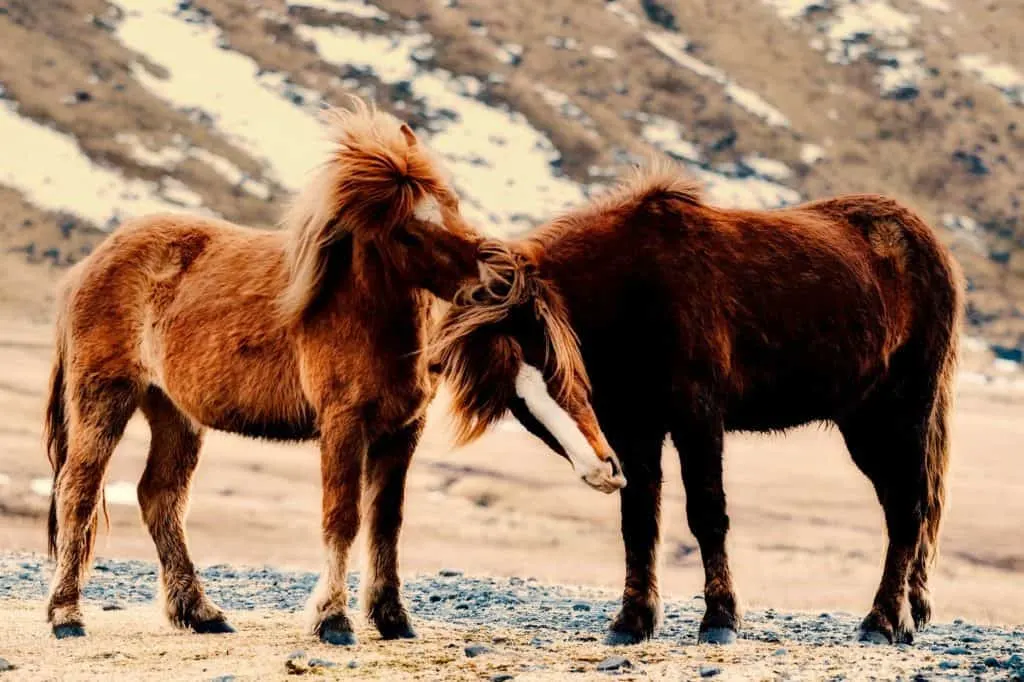
Icelandic horse tours typically run during the summer months. Riders will notice an additional gait referred to as the “tolt.” This is a natural gait similar to the running walk of the Tennessee Walker or Paso Fino breeds; it’s comfortable for riders and can quickly speed up. A visit to an Icelandic horse farm will reveal a variety of colors in a typical herd, and in winter, a shaggy double coat for warmth.
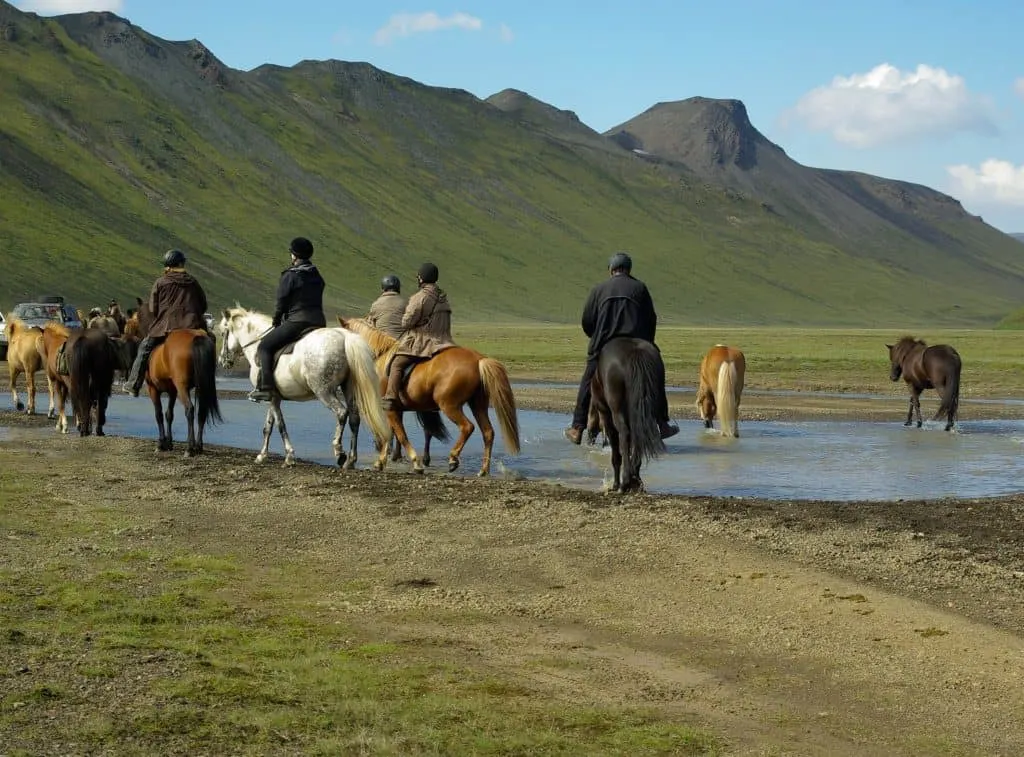
Fun Things to Do in Iceland for Culture and History Lovers
Much of the recent touristic focus in Iceland has to do with the amazing outdoor experiences visitors can have. But we would be remiss in our coverage of unique things to do in Iceland if we didn’t cover cultural and historic aspects which would make your visit memorable.
Iceland’s Storied History
Iceland’s recorded history dates back to the year 874 in Viking times, with Gaelic monk settlements carbon dated even further back. A Nordic version of parliamentary democracy was established in the 10th century by Norwegian emigrant chiefs.
In the 13th century, independent Iceland was weakened by internal conflict, allowing it to fall under Norwegian, and later Nordic Alliance rule. After that structure was dissolved in 1523, Iceland was Danish territory.
Interspersed throughout this history were times of hardship due to climate change, famine and natural disasters, most notably the Laki volcanic eruption in 1783 which killed 9,000 people and left only 20% of the livestock. Subsequently, starvation killed 25% of the country’s population.
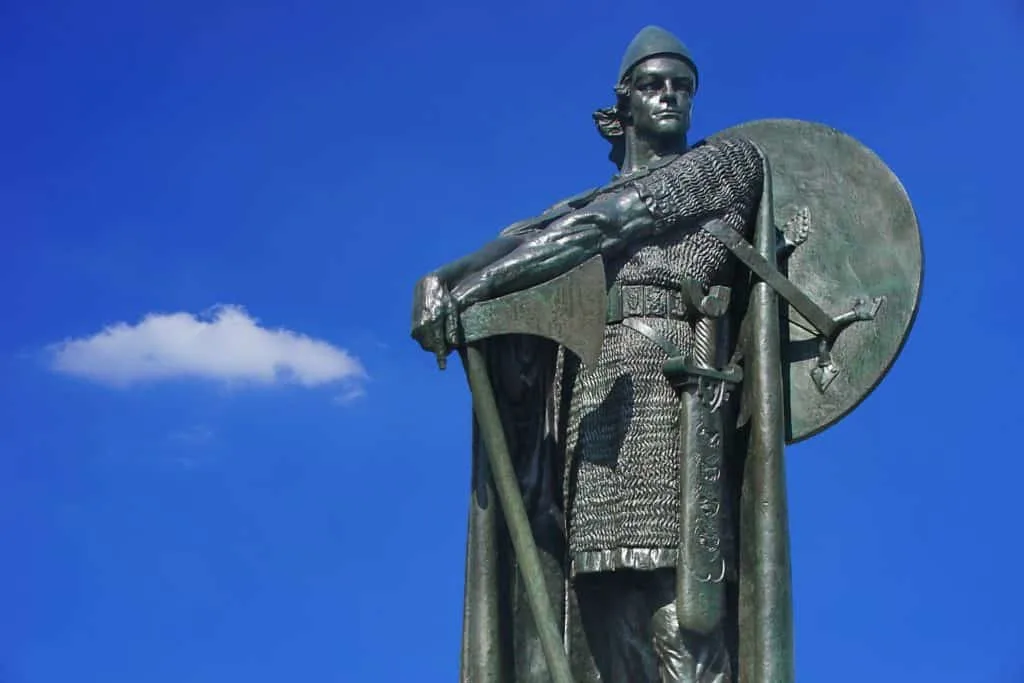
Prior to WWI, the country had prospered, but the standard of living diminished with food shortages. Between the wars, Iceland was hit hard by the Great Depression. Iceland’s governance bridged two worlds until WWII, splitting sovereignty with sharing the Danish monarchy.
Officially neutral in WWII, Iceland allowed British and American occupancy to guard against Nazi invasion after Denmark was conquered. This improved the economy significantly. In 1944, Iceland declared its full independence.
Most recently, economic instability led to a financial crisis in 2008; the country’s banking system collapsed and the people replaced their government with a coalition with the express purpose of stabilization. Four years later, the people elected a more center-right government.
Historic Attractions in Iceland
Historic attractions in Iceland aren’t limited to more recent eras. The Settlement Exhibition in Reykjavik is built over the site of a rediscovered Viking “long house.” The Stong ruins of a farmhouse destroyed by a volcanic eruption in the 12th century reveal grass and moss brick construction, discovered in the 1930s. Close by in the southern highlands is a 1974 folk museum which reconstructs the entire farm settlement, including a stave church.
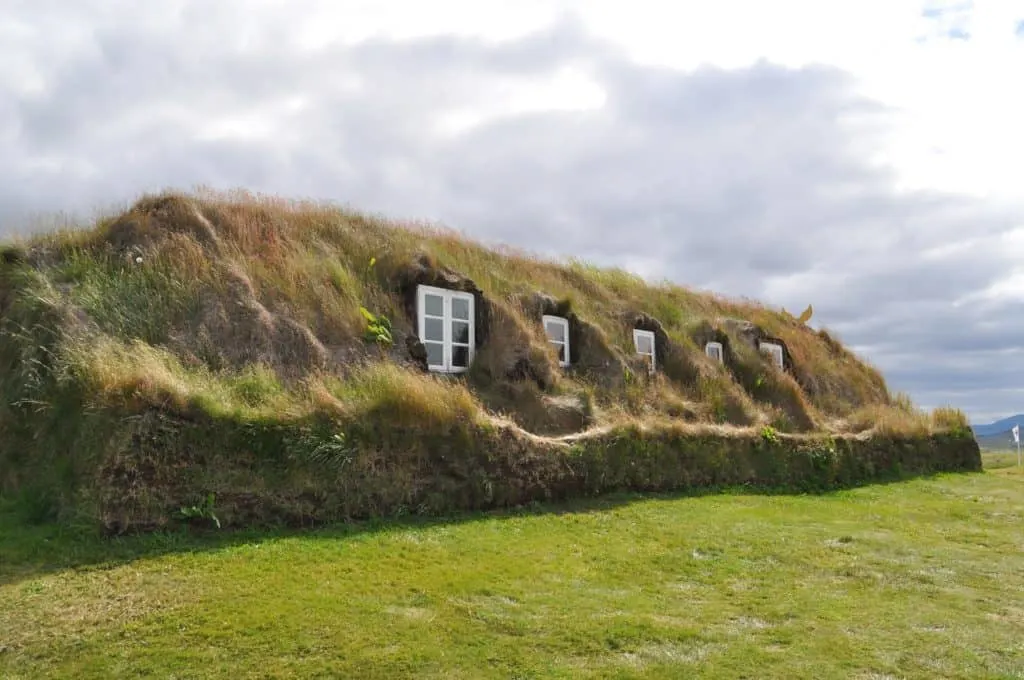
To get an idea of the stalwart nature of settlers in this environment, the thousand year old Keldur turf house and settlement depicts life as it was. Located outside Hella southeast of Reykjavik, Keldur is the oldest turf house in Iceland and is mentioned in the dramatic Njals saga, which tells of medieval blood feuds. This is one of the off the path Iceland attractions that is worth seeking out. The hall has a kitchen, sleeping loft and an escape tunnel, which was discovered in the 1930s. Supposedly, the escape tunnel is narrow at the beginning to force pursuers to go head first, leaving them vulnerable to beheading and blocking the tunnel to those behind them.
Grafarkirkja is the oldest church in Iceland, located outside of Hofsos in northern Iceland. The church is constructed of sod and surrounded by an earthen wall. Traditional wood carvings still decorate its rafters and altar, even though it was deconsecrated and used for storage. The National Museum of Iceland rebuilt it in 1950, faithful to its original appearance and construction.
Icelandic Culture is Nordic in Nature
As you might expect from its history, Iceland’s culture is overwhelmingly Nordic influenced. Classical Icelandic literature is saga-like and epic in nature. Silversmiths and wood carvers produce traditional and contemporary motifs with Scandinavian overtones.
Probably one of the most culturally unique things to do in Iceland which almost anyone can relate to is shopping for Icelandic knitwear. We remember how warm Icelandic wool hats, mittens and sweaters were in sub-zero Minnesota winters.
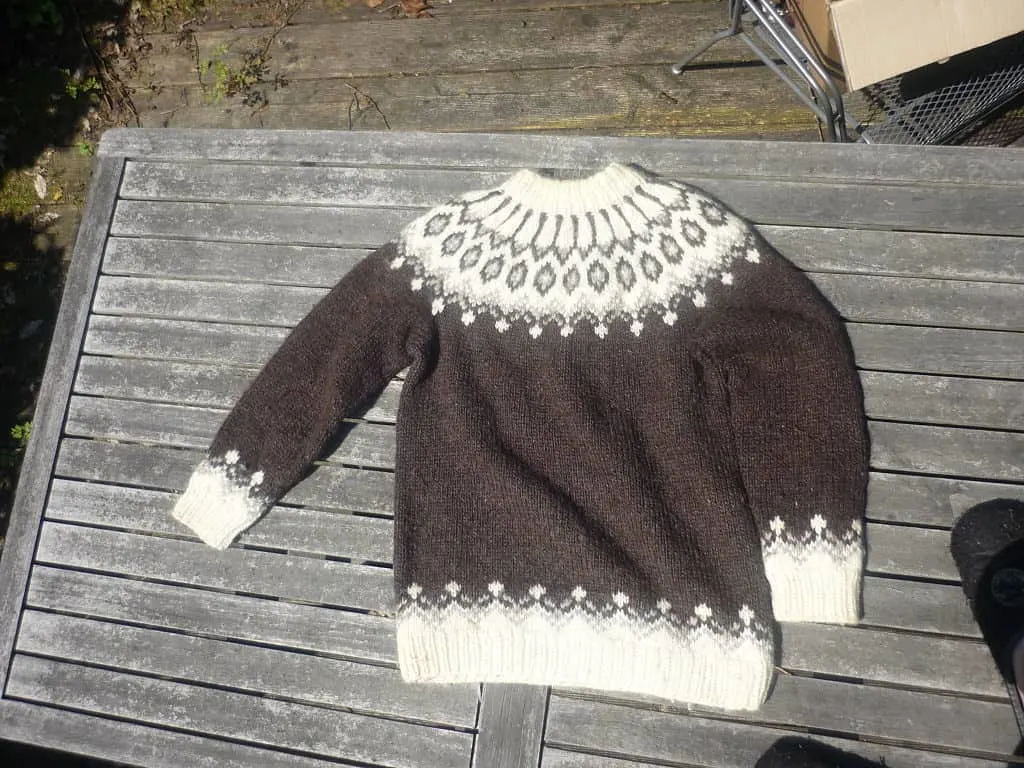
Photo: By Freimut Bahlo (Own work) [GFDL (https://www.gnu.org/copyleft/fdl.html) or CC BY-SA 3.0 (https://creativecommons.org/licenses/by-sa/3.0)], via Wikimedia Commons
The traditional Icelandic sweater pattern – also known as the Icelandic sweater lopapeysa – can’t be mistaken, with its runic-inspired geometric patterns. Likewise, the unique earthy colorations are lovingly interpreted in Icelandic wool coats, mitts and neckwear.
Unique Things to Do in Iceland for Beer Lovers and Foodies
Traditional and Innovative Cuisine in Iceland for Foodies
Contrary to what you might imagine, traditional Icelandic cuisine is varied. Things to do in Iceland for foodies wouldn’t be complete without sampling the traditional midwinter festival food – Thorramatur. This emerged in the 1950s and 60s as a rendition of Icelandic country foods, served in large wooden trough-like containers in portions for four people. On the menu would be cured meats and fish, boiled sheep’s head, rye bread, flatbreads and butter; accompaniments might be mashed potatoes or turnips. You also might see fermented shark and dried fish, but these are eaten all year long.

Photo: Photo: By The blanz (Own work) [CC BY-SA 3.0 (https://creativecommons.org/licenses/by-sa/3.0) or GFDL (https://www.gnu.org/copyleft/fdl.html)], via Wikimedia Commons
Fine dining in Iceland has recently undergone a transformation. Modern traditions have evolved into “New Nordic” cuisine, which, as you might expect, is fish and seafood heavy. The best fine dining restaurants in Iceland can be on the spendy side. Don’t let it deter you: the world-class cuisine at Dill has resulted in it being first restaurant in Iceland to be awarded a Michelin star in Reykjavik.
But don’t despair, a similar ethos can be found at Saemundur, the Kex hostel gastro pub.
Perlan, one of the first fine dining restaurants in Reykjavik, has merged with Laekjarbrekka restaurant in a townhouse dating back to the 1830s. Restored in the 1980s after being given protected status, the atmosphere is designed to hearken back to its original historical period. The menu revolves around classic Scandinavian cuisine featuring Icelandic lobster, fresh catch, salted cod, Icelandic mountain lamb and more.
Beer Lovers Will Enjoy a Brand New Scene in Iceland
Beer lovers will be happy that a decades-spanning ban on strong beer (and other alcohol) was finally lifted in 1989, resulting in a young, lively brew scene which has only recently come into its own. One of the best things to do in Iceland for beer lovers is go right to the source, and the two year old Skuli Craft Bar, which pivoted to specialize in craft beer shortly thereafter, has the goods. Skuli has partnered with Borg microbrewery out of Reykjavik, and other Icelandic beer producers. Iceland beers to try: Gaedinger and Olvisholt (from Reykjavik area), Brothers Brewery (from the Westman Islands), Kaldi (from northern Iceland), and Vifilfell, which produces Viking beer.
In conclusion, we hope we’ve given you some actionable ideas to include in your Iceland bucket list Unique and fun things to do in Iceland are not in short supply, even though the country has become an extremely popular destination in the past couple of years. Go off the beaten path to seek unique experiences in Iceland, and your trip will be memorable and rewarding.
Pinnable Images:
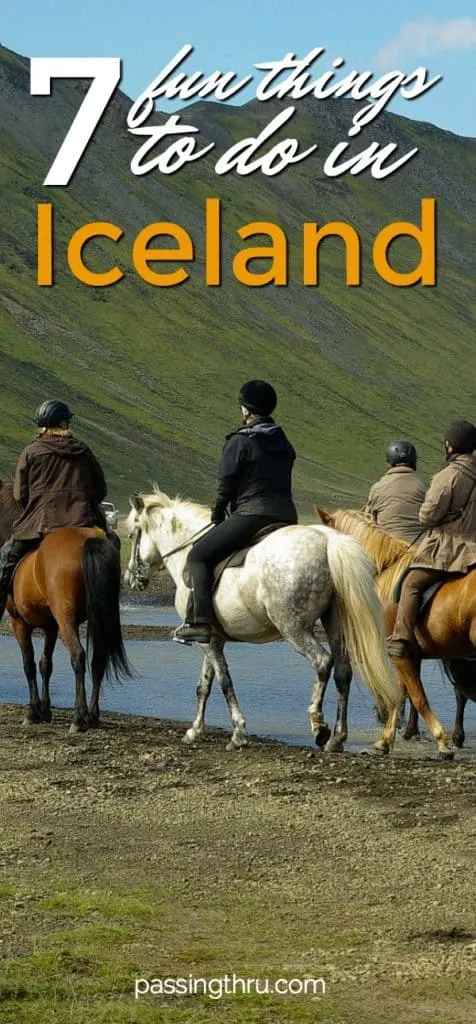
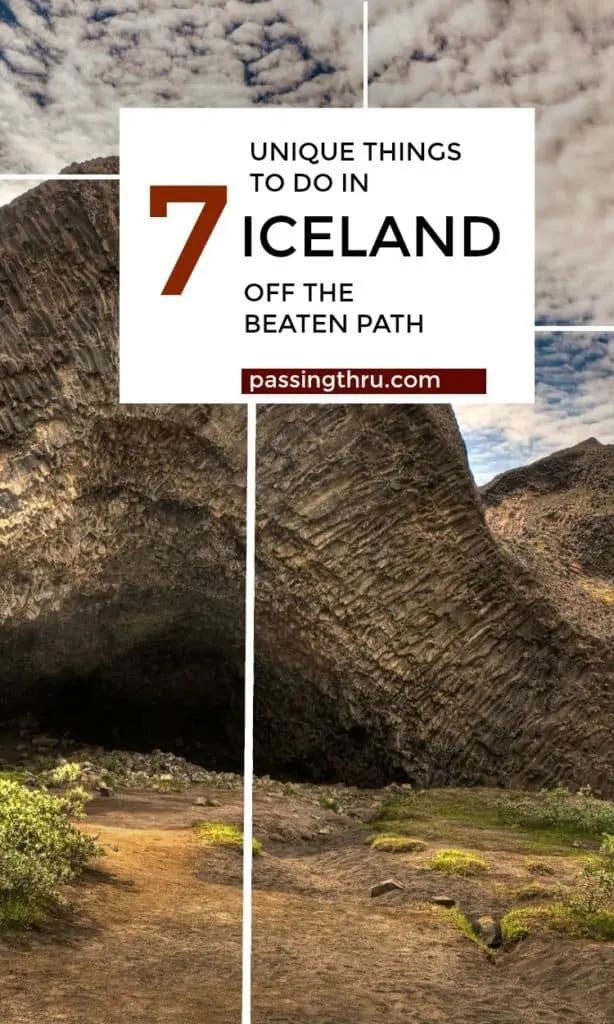
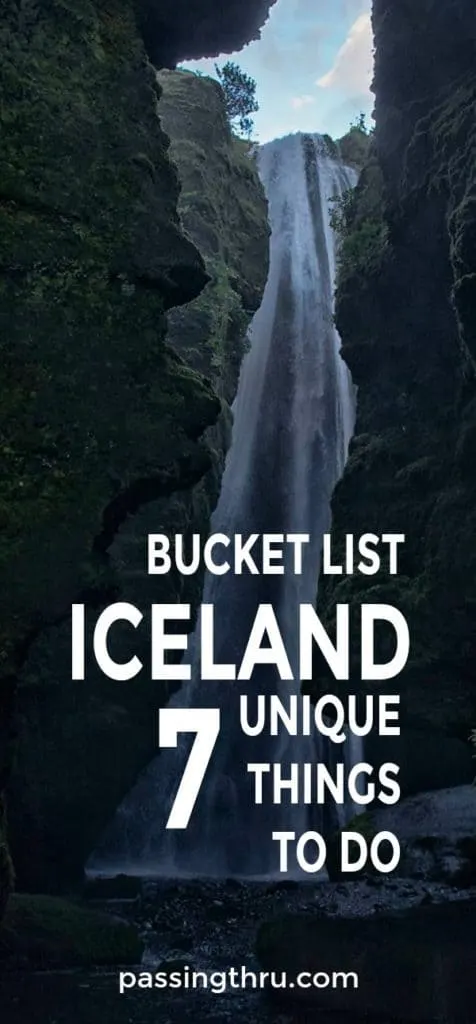
Tips for Trip Success
Book Your Flight
Find an inexpensive flight by using Kayak, a favorite of ours because it regularly returns less expensive flight options from a variety of airlines.
Book Your Hotel or Special Accommodation
We are big fans of Booking.com. We like their review system and photos. If we want to see more reviews and additional booking options, we go to Expedia.
You Need Travel Insurance!
Good travel insurance means having total peace of mind. Travel insurance protects you when your medical insurance often will not and better than what you get from your credit card. It will provide comprehensive coverage should you need medical treatment or return to the United States, compensation for trip interruption, baggage loss, and other situations.Find the Perfect Insurance Plan for Your Trip
PassingThru is a participant in the Amazon Services LLC Associates Program. As an Amazon Associate I earn from qualifying purchases.
To view PassingThru’s privacy policy, click here.

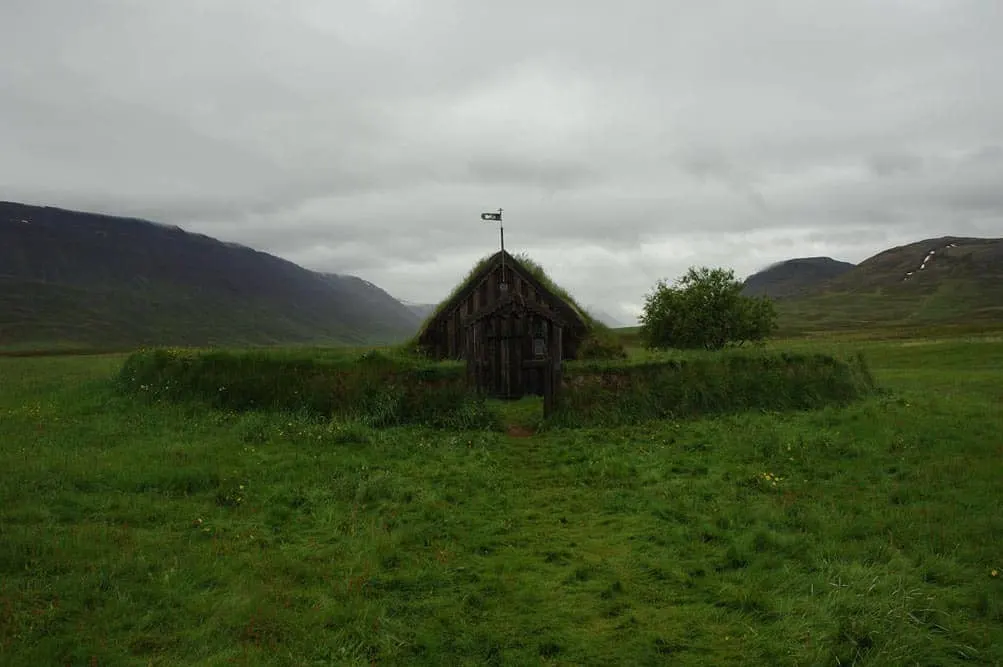
brenda
Thursday 14th of December 2017
Wow, what lovely photos. There are many wonderful things to see and do in Iceland.